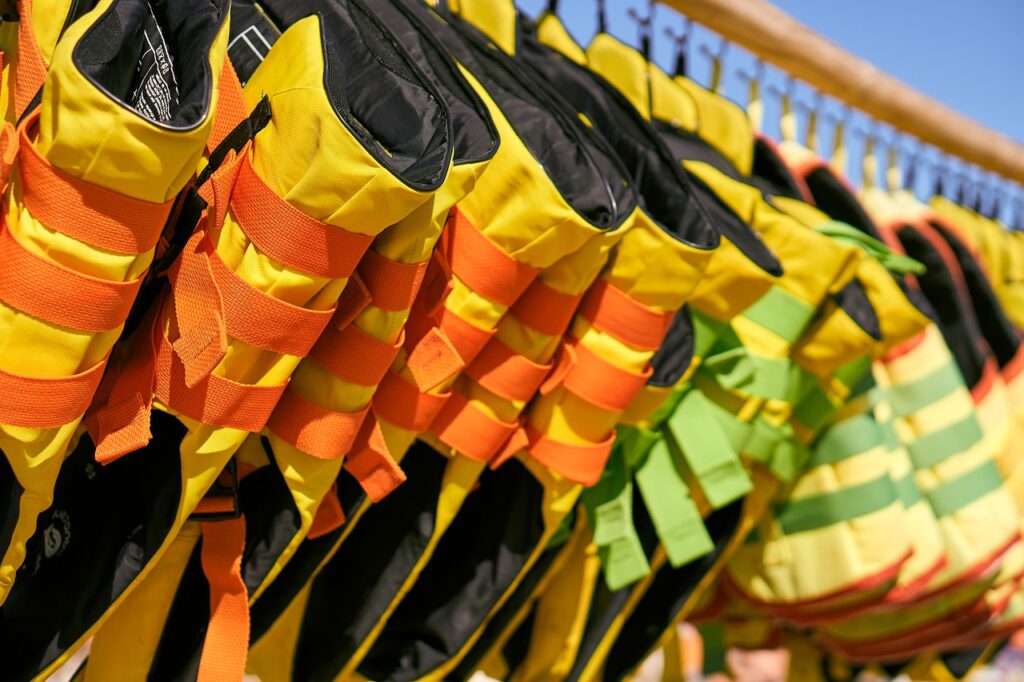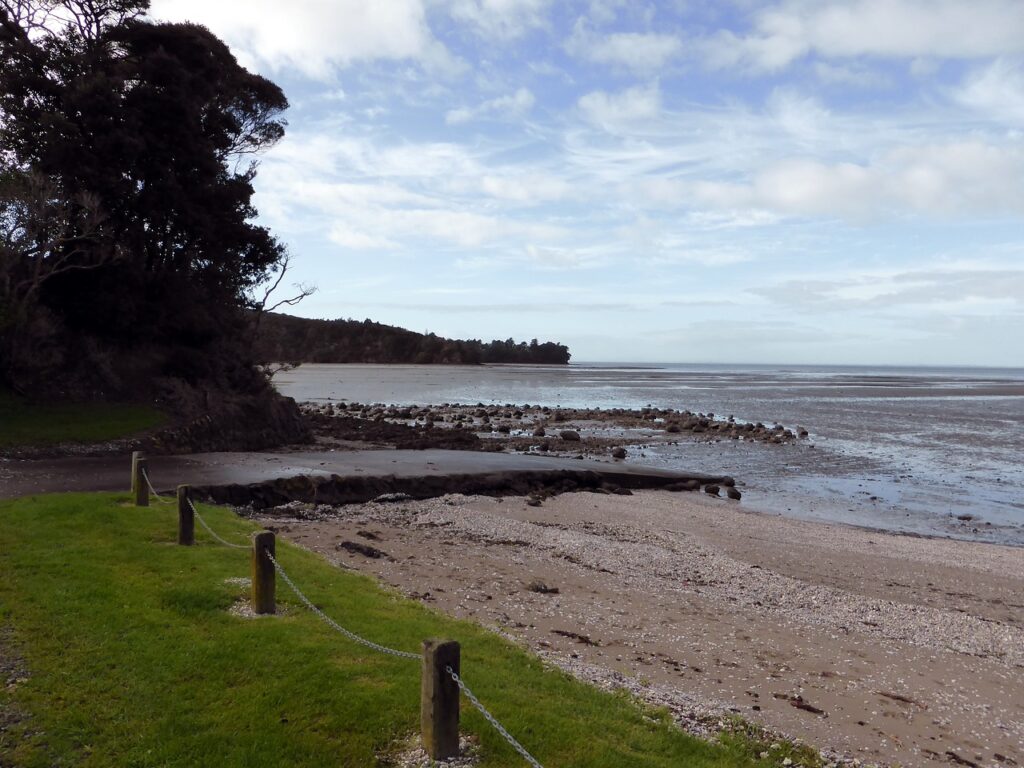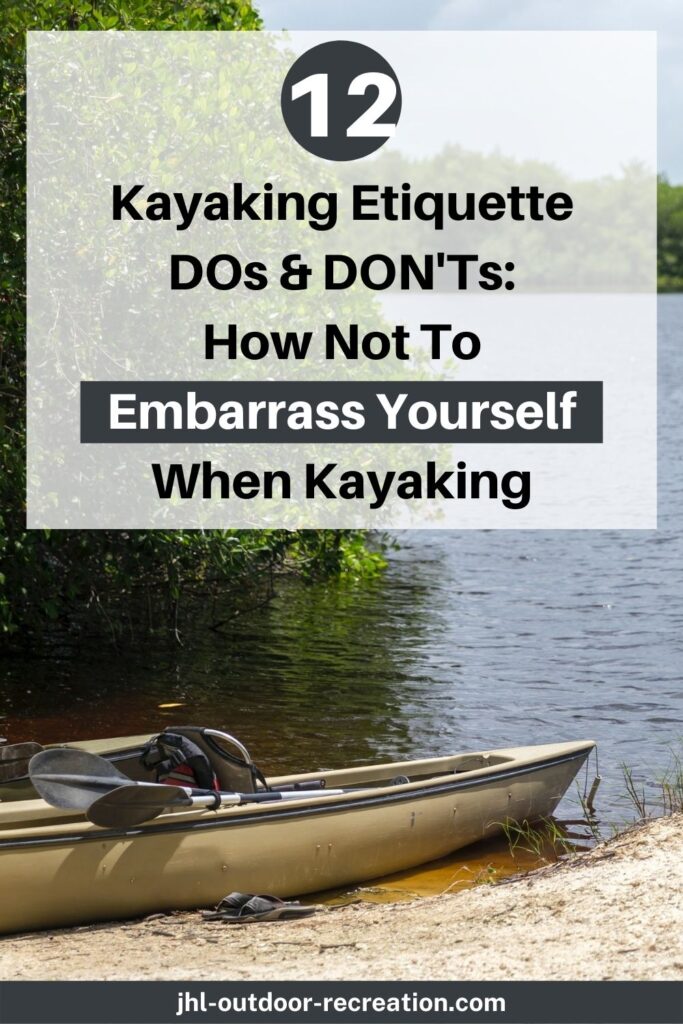If you love kayaking, you’d put in effort in training to improve skills. But, have you considered observing kayaking etiquette to be a great paddler?
Wait! Is kayaking etiquette even a thing? Even if it is, does it even important? – Why not?
Our parents teach us table manner when eating. We follow it to RESPECT other diners. – That is dining etiquette.
We know what should and shouldn’t do so we don’t offend others.
Most importantly, we don’t want to embarrass ourselves!
No matter what we do, we should behave. And this is the essence of etiquette.
Same goes to kayaking. We observe kayaking etiquette to show respect to other paddlers. Plus, we also know the safe way to paddle.
So, let’s look at 12 most common kayaking etiquette DOs & DON’Ts when paddling.
1. DOs
1.1 Wear safety gear

No matter what sports we have, safety is the utmost importance.
1.1.1 Personal floatation device (“PFD”)
Refuse to wear a PFD, aka life jacket, as you look awful when kayaking? – Plainly an absurd excuse not to wear a PFD.
Kayaking etiquette 101. Even if you are a good swimmer, you should also wear a PFD when kayaking. Besides, wearing a RIGHT size of PFD is what you need.
If your PFD is too small, it doesn’t give you enough buoyancy in case of capsizing. – Then, it defeats the purpose.
Or, if the PFD is too big, it can be slipped off easily. Again, it can’t save you.
Plus, remember to get a whistle and ATTACH to your PFD. – Not hanging on your neck!
If you hang it on your neck, chances are your whistle might get slipped off if you fall into the water. And you can’t use that to call for help.
1.1.2 Helmet
This is vital for whitewater kayaking.
Whitewater is much more turbulent than flatwater. Your head can get hit by any obstacles easily.
Again, don’t think you look cool without wearing a helmet. Other experienced paddlers might loathe and think you are totally clueless about it, which they are right.
So, regardless flatwater or whitewater kayaking, make sure you have the necessary safety gears before you paddle. – Even if you are a total beginner.
However, if you rent a kayak from kayak shop, get these items from the shop. The shop should provide this.
1.2 Wear proper gear
It’s a sunny day. And you can’t wait to paddle right away!
So, you try to wear as short or few as possible to avoid excessive sweating. – Well, who likes the sensation of sweat on our body?
Because of that, some people might just wear T-shirt or tank top for paddling. Some even paddle topless!
Well, it isn’t wrong, per se. And we totally understand their reason.
Again, we should wear for WATER, not for weather. That’s for your safety, too.
Remember, the water could be cold on a sunny day.
If we fall into the water, we could get HYPOTHERMIA, which is loss of body heat. And this could be lethal.
Hence, you can consider wearing WETSUITS or DRYSUITS, which help preserve body heat.
That’s why you can see some paddlers wearing these thick gears despite the hot weather. And you wonder whether they are insane. – It turns out that they are right.
1.3 Know water condition
The purpose is to know your BOUNDARY.
You can paddle either in calm or windy condition. And wind can impact the current of water.
If you have trouble navigating kayak, paddling in the wind might be bad for you, as the strong current makes it harder to paddle.
This can be dangerous if the wind and current are too strong, which is beyond your ability.
So, always check the water condition before paddling. You then can assess and decide.
For example, if the current is strong, you might want to paddle close to the shore or dock. If anything happens, people on the shore or dock can spot you. And save you.
1.3.1 Read whitewater
Whitewater is much more turbulent than flatwater. Hence, it is also much riskier.
So, how do you know if it is SAFE to paddle whitewater? – Well, get to learn to read whitewater.
In fact, this is a MUST when you paddle whitewater, even if you are a beginner.
There are two grading systems, ie.
- International Scale Of River Difficulty
- Whitewater Difficulty Scale
Without knowing this, you put yourself in danger.
For example, you paddle in a Class 4 whitewater without knowing the meaning. So, you don’t know the level of skills to maneuver.
And since the current is too strong, you can’t maneuver at all……
1.3.1.1 International Scale Of River Difficulty
This system is from American Whitewater Association. There are 6 classes within this system, i.e From Class I (Easy) to Class VI (Extreme and Exploratory Rapids).
The higher the class is, the greater the turbulence is, hence greater the skills to navigate the kayak.
In Class I, the water is calm with none or a few water waves. So, no maneuver skill is required. – Suitable class for beginners.
In Class VI, however, the water is very turbulent, which includes huge waves, rocks, steep gradient, water falls, fast and strong current. And it is unpredictable and extremely dangerous. – Even pro paddlers rarely attempt this because any slight error can be fatal.
1.3.1.2 Whitewater Difficulty Scale
This system is adopted by International Canoe Federation and German Canoe Association. Similar to the above, there are also 6 degrees, i.e. From WW I (Not Difficult) to WW VI (Limit of Navigability).
Again, the higher the class is, the greater the turbulence is. Hence, paddlers need greater maneuver skills to navigate the kayak.
You get to know the degree through 3 factors: VIEW, WATER and RIVERBED.
1.4 Observe boat ramp etiquette

Boat ramp is a place that connects roads / parking lots to the water (rivers, lakes or seas).
The purpose is to LAUNCH boats. Since kayak is a type of boat, paddlers can also use boat ramp to launch their kayaks.
Bear in mind where boaters should ONLY launch their boats on boat ramp, and nothing else. This is to minimize the time spent on boat ramp so it allows other boaters launch their boats as well.
Also, this is not a place for boaters to do all kinds of set up and preparation. This takes up time and other boaters have to wait.
So, if you see someone spending more 30 minutes, for instance, on boat ramp to do all these stuff, you know he is a jerk.
Make sure you do the set up IN ADVANCE before you drive your car to the boat ramp. Once everything is done, drive your car to the boat ramp and launch your kayak.
This process should take a few minutes. And once your launch your kayak, drive your car away right away.
1.5 Ask for / offer help if needed
Sometimes, we feel embarrassed to ask around when we need help. That’s because we don’t want to look stupid.
Instead, we remain silence and try to figure out ourselves. Well, you know it. We struggle.
When it comes to kayaking, surely we won’t know everything, especially when we are beginners.
So, try not to be shy and ask for help if needed. Remember, everyone was once a beginner. It’s better for us to ask than keep struggling while paddling. And it’s no fun.
The questions could be as simple as these. “how to hold paddle” “how to sit on kayak” “how to exit or enter the kayak”.
Likewise, if you are good at kayaking, you should offer help to others if needed. You know struggling is real and it’s not necessary.
As part of kayaking etiquette, your help matters a lot and it might help them save their lives. Or, you help them learn paddling faster and excite them.
But, there’s a catch. And I’ll explain this in the section “Don’t Teach / Lecture” below.
1.6 Know river signals
Imagine you are paddling in the middle of the water, and you drop your paddle accidentally. You can’t pick it up as it moves farther and farther.
So you need help. It turns out that you spot a paddler at a remote distance. Even when you scream for help, you can’t grab his attention.
What can you do instead?
The above shows verbal communication is not always feasible due to noise and distance.
To solve this, paddlers need to understand river signals.
River signals are essentially sign language / language by using paddles.
1.6.1 Basic river signals
Since it is a new SKILL to learn, it takes time to learn all possible river signals in all situations.
But, you can know the basic signals as follows:
- Are you ok? / Yes – Fist on your head. Apply for both question and reply.
- Stop / No – Spread your arms. Or, raise your paddle horizontally.
- Pointing direction – Use your hand / paddle to point to the direction.
- Need help – Wave your hands / paddle. Besides, you can blow whistle 3 times.
- Need first aid kit– Cross your arms in “X” shape in front of your chest or above your head. Also, you can blow whistle 1 time.
- Missed the paddle – Raise your hands upward. Close your fists and move in and out as if you are holding an “invisible” paddle.
- Eddy out – Draw circles and point to the direction.
And there are more!
Don’t ignore river signals, as this can save lives or help other get away from danger.
Paddling signals are vital when you paddle in group. If you don’t understand these signals, you might create a lot of hiccups to the group when paddling. – You might be seen as a trouble when paddling.
However, river signals might vary amongst paddling groups. So, when you join different paddling group, check with the group to see if there is any signal variation.
1.7 Read water buoys and markers
Let’s assume you are a cyclist who doesn’t know about traffic rules. And you don’t care.
So, you ride on the road AIMLESSLY as you wish. – Can you guess the possible outcomes?
Well, you could be riding on the wrong path; ride slow on highway; continue riding despite red traffic light……
Sound scary, huh?
This is exactly the same for SEA kayaking.
Put this aside. How do vessels and boats navigate on the ocean?
Do you notice there are various buoys and markers on the sea? These are for navigation purpose!
But, what do these mean?
You get to know International Association of Marine Aids To Navigation And Lighthouse Authorities (“IALA”). – IALA Maritime Buoyage Systems.
For sea paddlers, you need to know these to:
- Avoid invading wrong lanes in channel
- Avoid invading dangerous area
- Distance yourself from big boats to avoid collision.
Under IALA Maritime Buoyage Systems, there are several marks you need to know:
- Lateral marks
- Cardinal marks
- Safe water marks
- Isolated danger marks
- Special marks
- Emergency marks
Do note that this buoyage system also includes flashing signal for voyage at night. But, since we rarely paddle at night, this post doesn’t cover flashing signal.
1.7.1 Lateral marks

Similar to driving, buoyage system divides into 2 Regions, ie.
- Region A – Countries other than Region B
- Region B – North & South America (exclude Greenland), Japan, Philippines, Taiwan, Korea, Hawaii, and Easter Island
Get to know the region or your country, as navigation under both regions differs.
By referring the diagram, you’d notice the positions of PORT lateral marks and STARBOARD lateral marks of region A and B are SWITCHED.
Bear in mind where the diagram shows the direction to the port / upstream (i.e to source of water). For voyage to open water, you need to flip the orders.
1.7.1.1 Similarities of both regions
- Return to port / go upstream: Keep to the port marks (red)
- To open water / go downstream: Keep to the starboard marks (green)
- Colour: Red for port marks; Green for starboard marks
- Numbering system: Even numbers for port marks; Odd numbers for starboard marks
- Number ascending order: When boats return to port / go upstream
- Number descending order: When boats voyage to open water / go downstream
1.7.1.2 Differences of both regions
- Switched sides
- Top marks of port marks: Cylinder shape in Region A; Cone shape in Region B
- Top marks of starboard marks: Cone shape in Region B; Cylinder shape in Region A
- Return: “Red Right Return” rule for Region B
As a paddler, you know how boats enter or leave the channel. So, you can avoid COLLISION with the boats.
Also, you get to know the way to return to port or shore.
Thankfully, the region difference ONLY affects lateral marks, but not the rest.
1.7.2 Cardinal marks

These marks indicate hazard position and direction of safe water.
Hence, kayakers need to read cardinal marks in conjunction with COMPASSES. So, the sides of the vessels don’t matter.
Basically, the directions have different variations of top marks (2 cones) and colour arrangements (black and yellow).

1.7.3 Safe water marks
These indicate open and safe areas. Besides, it also acts as the beginning or the end of channels.
Thus, you can expect many boats or vessels will pass through these areas. Watch out and pay attention to it when you are paddling and avoid them if necessary.
The top mark is red SPHERE. The colour is both red and white vertical stripes.
1.7.4 Isolated danger marks
These buoys indicate dangerous area.
When you see these buoys, you definitely need to avoid approaching the area.
The top mark is 2 black spheres. The colour is red and black horizontal stripes.
1.7.5 Special marks
These are in YELLOW colour with the “X” shape top mark. Special marks can indicate many things, which can be either safe or hazard.
So, you might need to approach them and check the meaning, if you are keen to know, to know whether you should further enter or leave the area.
1.7.6 Emergency wreck marks
These indicate new wrecks / dangers that are yet to be identified.
Well, you might want to avoid these areas when paddling.
The appearance, though, is similar to special marks. They have yellow “+” shape top mark. The colour of the buoy is yellow and blue vertical stripes.
1.8 Handling after kayaking
Well, after your long hour paddling session, you want to call off the day. So, you paddle to the shore / dock and exit the kayak. – You expect to wrap up your paddling session just like that.
If this is what you think, maybe you need to change your mind.
What about your kayak and paddle? Do you want to leave them just like that?
You kayak is probably filled with water and dirt. Do you expect others to help you clean the kayak?
And if you rent the kayak, do you think the next person is fine with this filthy kayak? And that person might not even find the paddle as you “lose” the paddle.
Obviously, No!
So, once you exit the kayak, remember to pump out the water and drain it. – Unless that is your personal kayak and you don’t bother to clean it.
If you rent the kayak, remember to put the kayak in the prescribed or original place. Same goes to the paddle. Don’t create trouble for kayak shop. – That’s one of the purposes of observing kayaking etiquette.
2. DON’Ts
2.1 Litter
Sometimes, you may want to bring some food and drink for paddling. When you are hungry, you can eat and drink on kayak, and enjoy the beautiful scene. – How nice!
What about the plastic bags and water bottle? You look around and there is nobody. Then, you are tempted to throw them into the water, although you know that is wrong.
Is this a big deal to you? – Or, to our environment?
Marine pollution is a global issue. And the issue is worsening.
To show you how serious marine pollution is, here are some facts from Condor Ferries:
- 100 million sea animals die from plastic waste each year
- 100,000 sea animals found dead from getting entangled in plastic yearly. (Imagine those that are not found!)
- 70% of waste debris sinks; 15% float; 15% lands on beaches
- 8.3 million tons of plastics are discarded in the sea every year
- 500 marine locations are considered as dead zones globally. And the size is similar to the surface of the UK.
The list keeps going……
It doesn’t matter whether you paddle on lake or ocean, never ever litter. Remember that water animals can’t distinguish but treat it as their food. – And this endangers or even kills them!
No littering is the simplest to observe in kayaking etiquette. Let’s put in effort to reduce this problem. Simply keep the rubbish when paddling and throw it properly thereafter.
2.2 Invade inappropriate area
When sea kayaking, you can avoid hazard areas by reading buoys and marks.
But, this may not be clear when you kayak on lakes or some rivers.
Sometimes, we have the tendency to explore further when kayaking. And we come to less visited area.
What we are not aware of is the area might be DANGEROUS or PRIVATE.
This is a real story. When 3 kayakers were exploring Lukuga River in Congo, a crocodile attacked one of the kayakers, Hendrik Coetzee, and pulled him away. He is presumed dead as his body hasn’t been found.
But, how do we know whether the area is inappropriate?
Before paddling, check for any sign / warning post on specific area. Also, if you rent a kayak, check with the staff on this.
2.3 Whine / shout / yell

I saw a couple paddling a tandem kayak. Clearly, their strokes were out of synch and their kayak moved wobbly.
So, they whine and blame each other.
As outsiders, this is DISTRACTING because we can’t relax and enjoy the peaceful moment.
For those who whine or yell, this does nothing but hurts their relationship.
Meanwhile, kayaking is about fun and learning. Whining or yelling totally defeats the purpose.
Well, we are not perfect in paddling. And sure we need to figure it out and solve the problem.
Why not work together and find out the solutions, instead of whining?
2.4 Teach / lecture
You see some paddlers struggling in paddling. Well, they don’t know how to hold the paddles, or their sitting posture is off……
So, you try to be KIND and want to HELP them.
Without further ado, you approach (or paddle towards) them straight and point out their mistakes. And you show them the proper way to hold paddle, for instance.
Then, you expect them to give you a “thank you” look.
The thing is, they might find this offensive. In fact, your sudden lecture might hurt their pride.
They know they are struggling. And they might work together to figure it out (without letting other people know).
So, don’t teach or lecture other paddlers, unless they ask for your advice.
Let’s go back to the scenario above. Instead of pointing out the mistakes straight, you can try to ask them if anything you can help them. – Offer your help before teaching.
Based on their reply, you know whether they need help or they want to sort this out themselves.
Final thought: kayaking etiquette
If you want to be a great paddler, not only do you need to improve kayaking skills, but also need to observe kayaking etiquette.
Others may judge you if you don’t observe kayaking etiquette.
Besides, not only does kayaking etiquette define your character, but also helps you be aware of risk when paddling. So, you know how to paddle safely.
How many kayaking etiquette DOs and DON’Ts above do you observe?
Relevant posts
